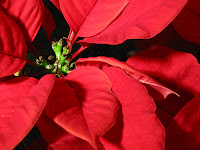Advent: The "Getting Ready" Season
 I really love traditions, especially at Christmas time. Already we've bought a poinsettia and put up the Christmas tree, collected wrapping paper and colorful ribbons. We're preparing our house. But what about our hearts?
I really love traditions, especially at Christmas time. Already we've bought a poinsettia and put up the Christmas tree, collected wrapping paper and colorful ribbons. We're preparing our house. But what about our hearts?There are at least 2 traditions that we practiced in our family when I was a kid that are technically "pre-Christmas" traditions (or at least are practiced side-by-side with other traditions of Christmas) that help us count the days until Christmas. They come from the church calendar season of Advent. One is the Advent Calendar and the other is the Advent Wreath.
 The Advent Calendar
The Advent CalendarThe origins of the Advent calendar come from German Lutherans who, at least as early as the beginning of the 19th century, would count the days of Advent physically. Often this meant simply drawing a chalk line on the door each day, beginning on December 1. Some families had more elaborate means of marking the days, such as lighting a new candle (perhaps the genesis of today's Advent wreath) or hanging a little religious picture on the wall each day.
The 24 candles might also be placed on a structure, which was known as an "Advent clock". In December, 1839, the first verifiable public Advent wreath was hung in the prayer hall of the Rauhes Haus (relief house) in Hamburg, although it had been a family practice in parts of German-speaking Europe since the 17th century.
The first known Advent calendar was handmade in 1851. According to the Austrian (NÖ) Landesmuseum, the first printed Advent calendar was produced in Hamburg in 1902 or 1903. Other authorities state that a Swabian parishioner, Gerhard Lang, was responsible for the first printed calendar in 1908.
Lang was certainly the progenitor of today's calendar. He was a printer in the firm Reichhold & Lang of Munich who, in 1908, made 24 little colored pictures that could be affixed to a piece of cardboard. Several years later, he introduced a calendar with 24 little doors. He created and marketed at least 30 designs before his firm went out of business in the 1930's. In this same time period, Sankt Johannis Printing Company started producing religious Advent calendars, with Bible verses instead of pictures behind the doors.
 The Advent Wreath
The Advent WreathThe first advent wreath was made by Johann Hinrich Wichern (1808-1881), a German theologian and educator, who was the founder of a home for poor children in the city of Hamburg. Since the children asked in advent every day, if it is Christmas, he built in 1839 a wooden ring (made out of a cartwheel) with 19 small red and 4 big white candles. Every day in advent a small candle was lit successively, but on the Sundays a white big one. Out of this idea the advent wreath of today with four candles has been emerged. In 1860 the people started to enwind the wooden ring with evergreen cuttings.
There are several interpretations of the symbolism of the advent wreath. The wreath is meant to represent God's eternity. The underlying symbolism is the accumulation of light as an expression of the growing anticipation of the birth of Jesus Christ, who is seen as "the light of the world" in Christian faith.
The wreath has 3 purple candles, representing penitence and royalty and symbolizing faithful expectation. A fourth candle is pink, representing joy and hope. Some wreaths have a larger, central fifth candle (generally white), which is lit on Christmas Eve or Christmas Day to signify Christ's birth.
The first candle is often called the prophet's candle, and is meant to signify the hope of Jesus' arrival. The second is generally called the Bethlehem candle, reminding Christians that God appeared to them in a humble manner; Bethlehem was located in the territory of one of the least powerful tribes of Israel. The third candle is the shepherds' candle, representing the joy that more than half of Advent is over. The final candle is the angels' candle, symbolising their peace and the message of good news that they offer.
Advent is an ancient season of the church calendar but it's relevant and current for our fast-paced times in the 21st century. It guides and centers us in the midst of a busy, hectic commercial season, to reflect on the coming of Jesus, his humble first coming and his powerful second coming.
In terms of origins, in 4th- and 5th-century Gaul and Spain, "Advent" was a preparation not for Christmas but for Epiphany. Epipha-what? That's the early-January celebration of such diverse events in Jesus's life as his Baptism, the miracle at Cana, and the visit of the Magi. In those days, Epiphany was set aside as an opportunity for new Christians to be baptized and welcomed into the church. So believers spent Advent's forty days examining their hearts and doing penance.
It was not until the 6th century that Christians in Rome began linking this season explicitly to the coming of Christ. But at that time, and for centuries after, the "coming" that was celebrated was not the birth of Jesus, but his Second Coming. It was not until the Middle Ages that the church began using the Advent season to prepare to celebrate Christ's birth. And even then, this newer sense of the Lord's "advent" or coming did not supplant the older sense—the Second Coming. And the muted, Lent-like mood of penitential preparation remained alongside the joyous anticipation of Jesus' birthday.
So, the modern liturgy divides Advent into a period, through December 16th, during which the focus is Christ's Second Coming, and a period, from December 17th to the 24th, focusing on His birth. It starts with sobering passages and prayers about the apocalyptic return of the Lord in judgment. Then it moves to Old Testament passages foretelling the birth of a messiah and New Testament passages trumpeting John the Baptist's exhortations and the angels' announcements.
Every year these rich Scriptural reminders and the traditional prayers that accompany them set my blood rushing a little faster and bring a rising excitement: Christ came with plenty of prior notice! Prophets and angels joined to proclaim his coming! And now I can join too, with the cloud of witnesses stretching back to apostolic times, in the same proclamation!
And in the protected, quiet times of meditation, I can respond as I imagine believers have done on every Advent since the tradition began:
I can bow my head and prepare my heart to receive the One who is always present, but who seems distant in the busyness of the season.
I can mourn for my hardness of heart.
I can hope in his grace.
And I can rejoice that in answer to the cry, "O come, O come, Emmanuel," he came.
Whew...so that's a lot of history, but hopefully it will help bring greater significance to your holidays this year. May you reflect in Advent and celebrate at Christmas!


Comments
Post a Comment